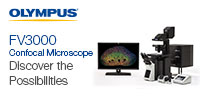Olympus IX70 Microscope Light Pathways
Olympus IX70 Microscope Light Pathways - Java Tutorial
This interactive tutorial explores illumination pathways in the Olympus IX70 research inverted tissue culture microscope. The microscope drawing presented above illustrates a cut-away diagram of the Olympus TIRFM-IX laser illuminator that contains a positioning and focusing system for light input through a FC connector from an external laser source. In addition, the illuminator is equipped with a port for an arc-style lamphouse that can supply light from a mercury or xenon lamp for epi-fluorescence excitation. Also included is the traditional transmitted light pathway, which operates with a tungsten-halogen illuminator positioned on a pillar above the stage.
The tutorial initializes with the microscope in epi-illumination mode and the Beam Intensity slider set to a position that is approximately 50 percent of full lamp intensity. Light emitted by the mercury arc lamp passes through the TIRFM-IX illuminator and into the filter cube turret positioned beneath the objective. The default interference filter cube contains an ultraviolet excitation filter with a bandpass centered at 350 nanometers. The cube turret can be rotated using the Emission Filter slider, which has four détentes, one for each filter cube. Excitation wavelengths available in the tutorial range from the near-ultraviolet to the long-wavelength visible and include ultraviolet (350 nanometers), blue (450 nanometers), green (550 nanometers), and red (650 nanometers). As the slider is translated, new filter cubes swing into position beneath the objective in succession, starting with the lower wavelength excitation filters and progressing through the higher wavelength filters. The small slider beside the EPI & TIR radio button toggles the microscope between total internal reflection (TIR) mode and epi-illumination by flipping the deflector mirror in the TIRFM-IX illuminator and rotating the cube turret to a filter set designed specifically for TIRFM. The TIR Angle slider, which is morphed from the Emission Filter slider when TIR mode is selected, can be utilized to adjust the critical angle of illumination for total internal reflection fluorescence microscopy. Moving this slider activates the micrometer adjustment of the TIRFM-IX illuminator and enables the visitor to translate the laser upward and downward in order to adjust the critical angle. When this angle has been achieved, a text block announcing Critical Angle Reached appears above the slider. Another set of radio buttons allows the visitor to switch between Transmission, Epi-fluorescence, and TIR illumination modes.
このページはお住まいの地域ではご覧いただくことはできません。



